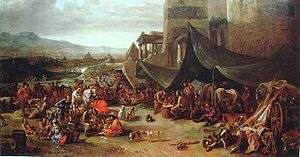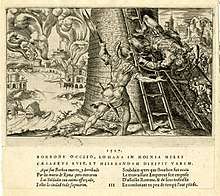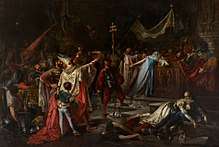Sack of Rome (1527)
The Sack of Rome, then part of the Papal States, on 6 May 1527 was carried out by the mutinous troops of Charles V, Holy Roman Emperor during the War of the League of Cognac. The largely Protestant German Landsknechts, mutinying over unpaid wages, entered the city of Rome and sacked it in a manner reminiscent of the barbarian pillages committed 1,100 years earlier. Spanish soldiers and Italian mercenaries also took part in the sack.[1] The sack debilitated the League of Cognac, an alliance formed by France, Milan, Venice, Florence and the Papacy against Charles V. Pope Clement VII took refuge in Castel Sant' Angelo, where he remained until a ransom was paid to the pillagers. Benvenuto Cellini, eyewitness to the events, described the sack in his works.
| Sack of Rome | |||||
|---|---|---|---|---|---|
| Part of the War of the League of Cognac | |||||
 The sack of Rome in 1527, by Johannes Lingelbach, 17th century (private collection). | |||||
| |||||
| Belligerents | |||||
|
|
| ||||
| Commanders and leaders | |||||
| |||||
| Strength | |||||
|
20,000 + (mutinous)
| ||||
| Casualties and losses | |||||
| 500 dead, wounded, or captured | 1,000–4,000 killed. (Around 8,000 killed by plague and disease after siege) | ||||
| 45,000 civilians dead, wounded, or exiled (most were casualties of the disease and plague that crippled the city) | |||||
Preceding events
The growing power of Holy Roman Emperor Charles V alarmed Pope Clement VII, who perceived Charles as attempting to dominate the Catholic Church and Italy. In an effort to resist the influence of the Habsburg dynasty, Clement VII formed an alliance with Charles V's arch-enemy, King Francis I of France, which came to be known as the League of Cognac.
The army of the Holy Roman Emperor defeated the French army in Italy, but funds were not available to pay the soldiers. The 34,000 Imperial troops mutinied and forced their commander, Charles III, Duke of Bourbon and Constable of France, to lead them towards Rome. Apart from some 6,000 Spaniards under the Duke, the army included some 14,000 Landsknechte under Georg von Frundsberg, some Italian infantry led by Fabrizio Maramaldo, the powerful Italian cardinal Pompeo Colonna and Luigi Gonzaga, and also some cavalry under the command of Ferdinando Gonzaga and Philibert, Prince of Orange. Though Martin Luther himself was not in favor of attacking Rome or the Pope, some who considered themselves followers of Luther's Protestant movement viewed the papal capital as a target for religious reasons, and shared with the soldiers a desire for the sack and pillage of a city that appeared to be an easy target. Numerous bandits, along with the League's deserters, joined the army during its march.
The Duke left Arezzo on 20 April 1527, taking advantage of the chaos among the Venetians and their allies after a revolt broke out in Florence against Pope Clement VII's family, the Medici. In this way, the largely undisciplined troops sacked Acquapendente and San Lorenzo alle Grotte, and occupied Viterbo and Ronciglione, reaching the walls of Rome on 5 May.
Sack
The imperial troops were 14,000 Germans, 6,000 Spanish, and an uncertain number of Italian infantry.[2] The troops defending Rome were not at all numerous, consisting of 5,000 militiamen led by Renzo da Ceri and 189[3] papal Swiss Guard. The city's fortifications included the massive walls, and it possessed a good artillery force, which the imperial army lacked. Duke Charles needed to conquer the city swiftly, to avoid the risk of being trapped between the besieged city and the League's army.
On 6 May, the imperial army attacked the walls at the Gianicolo and Vatican Hills. Duke Charles was fatally wounded in the assault, allegedly shot by Benvenuto Cellini. The Duke was wearing his famous white cloak to mark him out to his troops, but it also had the unintended consequence of pointing him out as the leader to his enemies. The death of the last respected commander of authority among the Imperial army caused any restraint in the soldiers to disappear, and they easily captured the walls of Rome the same day. Philibert of Châlon took command of the armies, but he was not as popular or feared, leaving him with little authority.
In the event known as the Stand of the Swiss Guard, the Swiss, alongside the garrison's remnant, made their last stand in the Teutonic Cemetery within the Vatican. Their captain, Kaspar Röist, was wounded and later sought refuge in his house, where he was killed by Spanish soldiers in front of his wife.[4] The Swiss fought bitterly, but were hopelessly outnumbered and almost annihilated. Some survivors, accompanied by a band of refugees, fell back to the Basilica steps. Those who went toward the Basilica were massacred, and only 42 survived. This group of 42, under the command of Hercules Goldli, managed to stave off the Habsburg troops pursuing the Pope's entourage as it made its way across the Passetto di Borgo, which was a secret corridor that still connects the Vatican City to Castel Sant'Angelo.[4]

After the execution of some 1,000 defenders of the papal capital and shrines, the pillage began. Churches and monasteries, as well as the palaces of prelates and cardinals, were looted and destroyed. Even pro-imperial cardinals had to pay to save their properties from the rampaging soldiers. On 8 May, Cardinal Pompeo Colonna, a personal enemy of Clement VII, entered the city. He was followed by peasants from his fiefs, who had come to avenge the sacks they had suffered at the hands of the papal armies. Colonna was touched by the pitiful conditions in the city and gave refuge to some Roman citizens in his palace.
The Vatican Library was saved because Philibert had set up his headquarters there.[5][lower-alpha 1] After three days of ravages, Philibert ordered the sack to cease, but few obeyed. In the meantime, Clement remained a prisoner in Castel Sant'Angelo. Francesco Maria della Rovere and Michele Antonio of Saluzzo arrived with troops on 1 June in Monterosi, north of the city. Their cautious behaviour prevented them from obtaining an easy victory against the now totally undisciplined imperial troops. On 6 June, Clement VII surrendered, and agreed to pay a ransom of 400,000 ducati in exchange for his life; conditions included the cession of Parma, Piacenza, Civitavecchia and Modena to the Holy Roman Empire (however, only the last would change hands). At the same time Venice took advantage of this situation to capture Cervia and Ravenna, while Sigismondo Malatesta returned to Rimini.
Aftermath and effects

Often cited as the end of the Italian High Renaissance, the Sack of Rome impacted the histories of Europe, Italy, and Catholicism, creating lasting ripple effects throughout world culture and politics.[6]
Before the Sack, Pope Clement VII opposed the ambitions of Emperor Charles V and the Spanish, whom he believed wished to dominate Italy and the Church. Afterward, he no longer had the ability to do so, lacking the military and financial resources.[7] To avert more carnage, the Pope adopted a conciliatory policy toward the Emperor. Charles V, in turn, exerted increasing control over the Church and much of Italy.[8][9]
The Sack had major repercussions for Italian society and culture, and in particular, for Rome. Clement VII's War of the League of Cognac would be the last fight for Italian independence and unity until the nineteenth century.[10] Rome, which had been a center of Italian High Renaissance culture and patronage before the Sack, suffered depopulation and economic collapse, causing artists and thinkers to scatter.[11] The city's population dropped from over 55,000 before the attack to 10,000 afterward. An estimated 6,000 to 12,000 people were murdered. Many Imperial soldiers also died in the aftermath, largely from diseases caused by masses of unburied corpses in the streets. Pillaging finally ended in February 1528, eight months after the initial attack, when the city's food supply ran out, there was no one left to ransom, and plague appeared.[12][13] Clement VII would continue artistic patronage and building projects in Rome, but a perceived Medicean golden age had passed.[14] The city did not recover its population losses until approximately 1560. [15]
A power shift – away from the Pope, toward the Emperor – likewise produced lasting consequences for Catholicism. The Emperor, for his part, professed great embarrassment that his troops imprisoned the Pope; however, he'd sent armies to Italy with the goal of bringing the latter under his control. After doing so, Charles V reformed the Church in his own image.[16] Clement VII, now making executive decisions under duress, rubber-stamped the Emperor's demands – among them naming cardinals nominated by the latter, unworthy from any religious standpoint, (although it is important to note that during the 1500s, many cardinals were appointed on the basis of familial connections); crowning Charles Holy Roman Emperor at Bologna in 1530; and refusing to annul the marriage of Charles' beloved aunt, Catherine of Aragon, to King Henry VIII of England, prompting the English Reformation.[17][18][19][20] Likewise, without any conditions, Clement agreed to cede the worldly and political possessions of the bishopric of Utrecht to Charles' family, the Habsburgs. Cumulatively, these actions changed the complexion of the Church, steering it away from Renaissance freethought personified by the Medici Popes, toward the religious orthodoxy exemplified by the Counterreformation. After Clement's death in 1534, under the influence of Charles V and particularly his son King Phillip II of Spain (1556-1598), the Inquisition became pervasive, and the humanism encouraged by Renaissance culture came to be viewed as contrary to the teachings of the Church.[21][22]
The Sack also contributed to making permanent the split between Catholics and Protestants. Before the Sack, the Emperor and Pope disagreed over how to address Martin Luther and the Protestant Reformation, which was spreading in the Emperor's German territories. Charles advocated for calling a Church Council; Clement opposed this based on historical precedent, believing that he would be deposed or killed, (technically on account of his illegitimate birth but, in actuality, due to the Emperor's desire for a more pliable Pope). [23] Clement advocated for fighting a Holy War to unite Christendom; Charles opposed this because his armies and treasury were occupied in fighting other wars. After the Sack, Clement relented to Charles' wishes, agreeing to call a Church Council and naming the city of Trent as its site. He did not convene the Council of Trent during his lifetime, fearing that the event would be a dangerous trap and powerplay. In 1545, eleven years after Clement's death, his successor Pope Paul III convened the Council of Trent, which as the Emperor predicted, did much to reform the corruption present in certain orders of the Catholic Church. [24] However, by 1545, the moment for reconciliation between Catholics and Protestants – arguably a possibility during the 1520s, given cooperation between the Pope and Emperor – had passed. In assessing the effects of the Sack of Rome, Martin Luther commented: "Christ reigns in such a way that the Emperor who persecutes Luther for the Pope is forced to destroy the Pope for Luther" (LW 49:169).
In commemoration of the Swiss Guard's bravery in defending Pope Clement VII during the Sack of Rome, recruits to the Swiss Guard are sworn in on 6 May every year.[25]
Notes
- The library was not, however, undamaged or unmolested. The Sack is thought to have been the occasion of the loss or destruction of Nicolaus Germanus's globes of the terrestrial and celestial spheres, the first modern globes.
References
- Eggenberger, David (1985). An Encyclopedia of Battles: Accounts of Over 1,560 Battles from 1479 B.C. to the Present. Courier Corporation. p. 366. ISBN 9780486249131.
- Dandeler, "Spanish Rome" New Haven: Yale University Press. 2001 pp57
- "The Swiss Guard - History". www.vatican.va. Archived from the original on 31 December 2008. Retrieved 4 May 2018.
- "History of the Swiss Guards", Roman Curia, 7 December 2003. Retrieved 21 September 2010.
- Durant, Will. 1953. The Renaissance. Simon & Schuster.
- https://www.encyclopedia.com/history/modern-europe/wars-and-battles/sack-rome
- https://dailyhistory.org/Did_the_Sack_of_Rome_in_1527_end_the_Renaissance_in_Italy%3F
- https://dailyhistory.org/Did_the_Sack_of_Rome_in_1527_end_the_Renaissance_in_Italy%3F
- Chastel, Andre (1983). The Sack of Rome, 1527. Princeton: Princeton University Press. p. 73.
- "The Italian Monarchist: A Case for Italian Unification". 10 June 2015.
- Ruggiero, Guido (2017). The Renaissance in Italy: a Social and Cultural History of the Rinascimento. Cambridge: Cambridge University Press. p. 73. ISBN 9780521719384.
- Watson, Peter -- Boorstin, Op. cit., page 180
- https://dailyhistory.org/Did_the_Sack_of_Rome_in_1527_end_the_Renaissance_in_Italy%3F
- https://www.encyclopedia.com/history/modern-europe/wars-and-battles/sack-rome
- Partner, Peter (1976). Renaissance Rome 1500-1559: A Portrait of a Society Portrait of a Society 1500-1559. Berkeley: University of California Press. p. 83. ISBN 0520039459.
- Chastel, Andre (1983). The Sack of Rome, 1527. Princeton: Princeton University Press. p. 73.
- https://www.encyclopedia.com/people/philosophy-and-religion/roman-catholic-popes-and-antipopes/clement-vii
- https://www.encyclopedia.com/history/modern-europe/wars-and-battles/sack-rome
- Holmes (1993). p192
- Froude (1891), p35, pp90-91, pp96-97 Note: the link goes to page 480, then click the View All option
- "Spanish Inquisition | Definition, History, & Facts".
- https://dailyhistory.org/Did_the_Sack_of_Rome_in_1527_end_the_Renaissance_in_Italy%3F
- "The Mad Monarchist: Papal Profile: Pope Clement VII". 9 July 2012.
- "CATHOLIC ENCYCLOPEDIA: Pope Paul III".
- "May 6 & the Swiss Guard Induction Ceremony | Papal Artifacts".
Bibliography
- Buonaparte, Jacopo (1830). Sac de Rome, écrit en 1527 par Jacques Bonaparte, témion oculaire: traduction de l'italien par N. L. B. (Napoléon-Louis Bonaparte). Florence: Imprimerie granducale.
- Arborio di Gattinara, Mercurino (Marchese) (1866). Il sacco di Roma nel 1527: relazione. Ginevra: G.-G. Fick.
- Carlo Milanesi, ed. (1867). Il Sacco di Roma del MDXXVII: narrazione di contemporanei (in Italian). Firenze: G. Barbèra.
- Schulz, Hans (1894). Der Sacco di Roma: Karls V. Truppen in Rom, 1527-1528. Hallesche Abhandlungen zur neueren Geschichte (in German). Heft 32. Halle: Max Niemeyer.
- Lenzi, Maria Ludovica (1978). Il sacco di Roma del 1527. Firenze: La nuova Italia.
- Chamberlin, E. R. (1979). The Sack of Rome. New York: Dorset.
- Pitts, Vincent Joseph (1993). The man who sacked Rome: Charles de Bourbon, constable of France (1490-1527). American university studies / 9, Series 9, History, Vol. 142. New York: P. Lang. ISBN 978-0-8204-2456-9.
- Gouwens, Kenneth (1998). Remembering the Renaissance: Humanist Narratives of the Sack of Rome. Leiden-New York: BRILL. ISBN 90-04-10969-2.
- Gouwens, Kenneth; Reiss, Sheryl E. (2005). The Pontificate of Clement VII: History, Politics, Culture ((collected papers) ed.). Aldershot (UK); Burlington (Vt.): Ashgate. ISBN 978-0-7546-0680-2.
- Froude, James Anthony (1891). The Divorce of Catherine of Aragon. Kessinger Publishing, reprint 2005. ISBN 1417971096.
- Holmes, David L. (1993). A Brief History of the Episcopal Church. Continuum International Publishing Group. ISBN 1563380609.
- Tuchman, Barbara W. (1985). The March of Folly: From Troy to Vietnam. Random House Trade Paperbacks. ISBN 0345308239.
External links
| Wikimedia Commons has media related to Sack of Rome (1527). |
- Pope's guards celebrate 500 years, BBC News Online; dated and retrieved 22 January 2006
- Vatican's honour to Swiss Guards, BBC News Online; dated and retrieved 6 May 2006